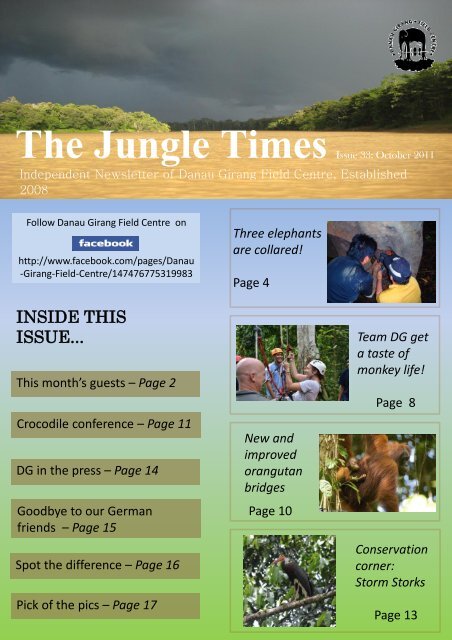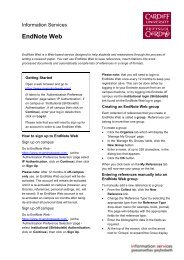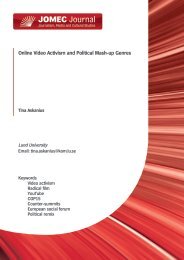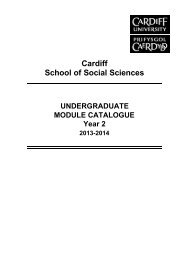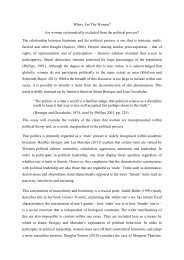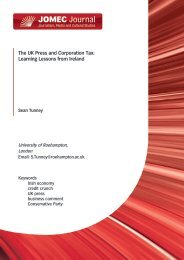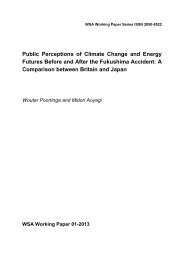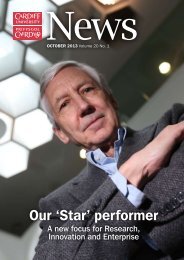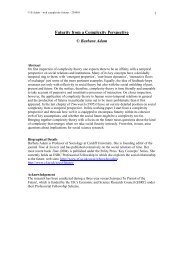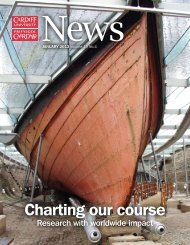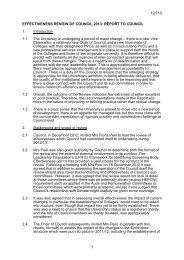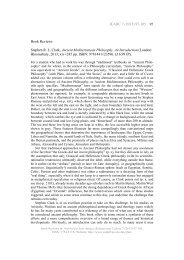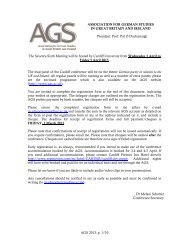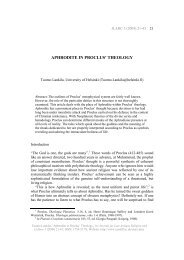The Jungle Times - Cardiff University
The Jungle Times - Cardiff University
The Jungle Times - Cardiff University
Create successful ePaper yourself
Turn your PDF publications into a flip-book with our unique Google optimized e-Paper software.
<strong>The</strong> <strong>Jungle</strong> <strong>Times</strong><br />
INSIDE THIS<br />
ISSUE...<br />
Issue 33: October 2011<br />
Independent Newsletter of Danau Girang Field Centre, Established<br />
2008<br />
Follow Danau Girang Field Centre on<br />
http://www.facebook.com/pages/Danau<br />
-Girang-Field-Centre/147476775319983<br />
This month’s guests – Page 2<br />
Crocodile conference – Page 11<br />
DG in the press – Page 14<br />
Goodbye to our German<br />
friends – Page 15<br />
Spot the difference – Page 16<br />
Pick of the pics – Page 17<br />
Three elephants<br />
are collared!<br />
Page 4<br />
New and<br />
improved<br />
orangutan<br />
bridges<br />
Page 10<br />
Team DG get<br />
a taste of<br />
monkey life!<br />
Page 8<br />
Conservation<br />
corner:<br />
Storm Storks<br />
Page 13
Page 2 October 2011<br />
This Month’s Guests….<br />
It has been a busy few weeks here at DG and we’ve<br />
seen many faces come and go. This month’s guests<br />
included:<br />
Lyndsey Stanton – Houston zoo<br />
Check out Lyndsey’s blog entry at :<br />
Diana Marsilio<br />
“I have had such a great experience so far<br />
at DGFC. I have helped with many different<br />
projects and have learned so much. I love<br />
seeing all the animals of the jungle and<br />
have grown to love everything about the<br />
field centre (even the cold showers and<br />
crazy hornbills).<br />
I want to be like Danica and stay forever!”<br />
http://houstonzooblogs.org/wildconservation/2011/10/a-message-froma-houston-zoo-intern-in-borneo/<br />
Diana studied her masters with resident primatologist, Danica Stark. <strong>The</strong><br />
two were able to catch up when Diana decided to visit DG to gain some<br />
field experience<br />
Niall McCann – PhD student at <strong>Cardiff</strong> university<br />
Niall and his girlfriend Rachel popped by for a couple of days after<br />
attending a Tapir conference in Kuala Lumpur .
Page 3 October 2011<br />
This Month’s Guests….<br />
Yayasan Sabah group<br />
20 staff from the Imbak Canyon Reserve dropped by for a night,<br />
on the last leg of their Sabah-wide tour. In 2009 the Imbak<br />
Canyon was granted class 1 forest reserve protection status by<br />
the Sabah state government and is now managed by Yayasan<br />
Sabah. Staff from the reserve visited various field and visitor<br />
centres throughout Sabah, in a collaborative effort to exchange<br />
ideas and share experience. <strong>The</strong> visitors were given a<br />
presentation by Danica Stark on the day to day running of DG,<br />
followed by a question and answer session with our manager,<br />
Mark.<br />
Chester Zoo group<br />
Staff from Chester Zoo came to build the new orangutan<br />
bridges, with the assistance of the Ropeskills climbing<br />
team and DG staff. Check out page 10 for the full story …
Page 4 October 2011<br />
Elephant Collaring<br />
Three Bornean elephants were<br />
fitted with satellite collars on 25<br />
and 26 October 2011 in Lot 5 of<br />
the Lower Kinabatangan Wildlife<br />
Sanctuary (LKWS) as part of a<br />
collaborative project between<br />
the Sabah Wildlife Department<br />
(SWD), the NGO HUTAN and the<br />
Danau Girang Field Centre<br />
(DGFC). This project is funded by<br />
the Asian Elephant Conservation<br />
Fund from the U.S Fish and<br />
Wildlife Service, Mohamed bin<br />
Above: Wildlife Rescue Unit members (in black) and<br />
Benoit Goossens (in yellow), director of DGFC.<br />
Zayed Species Conservation Fund, Elephant Family, Houston<br />
Zoo and Columbus Zoo.<br />
Above: Jibius Dausip preparing a syringe with<br />
anaesthetic.<br />
Last week, members of<br />
the DGFC and the SWD’s<br />
Wildlife Rescue Unit<br />
(WRU) re-collared one<br />
bull named Gading (he<br />
was first collared in July<br />
2008) and collared two<br />
females named Putut<br />
(she has a very short<br />
tail) and Jasmin.
Page 5 October 2011<br />
Above: Dr Benoit Goossens and Wildlife<br />
Rescue Unit's member taking measurements<br />
of Jasmin.<br />
Above: Dr Diana Ramirez from Wildlife<br />
Rescue Unit treating a wound on Gading's<br />
trunk, probably caused by a fight with<br />
another bull.<br />
We now have 5 different<br />
elephants (4 females and one<br />
male) fitted with a satellite<br />
collar and providing important<br />
information on the available<br />
suitable elephant habitat in<br />
the region, allowing the<br />
management authorities to<br />
prioritise crucial areas in order<br />
to rebuild landscape<br />
connectivity along the<br />
Kinabatangan river. Extensive<br />
agriculture through palm oil<br />
plantations has considerably<br />
reduced the habitat of the<br />
elephant in the Kinabatangan,<br />
therefore increasing humanelephant<br />
conflicts. <strong>The</strong> herd<br />
there, estimated at about 200<br />
to 250 individuals, finds it<br />
difficult to move between<br />
flooded lands, swamps, fenced<br />
plantations, villages, and<br />
nature lodges. Moreover,<br />
uncontrolled tourism with<br />
sometimes up to 20 boats<br />
aligned along river banks, less<br />
than 5 meters from where the<br />
elephants graze, increases the<br />
pressure on the herd.
Page 6<br />
October 2011<br />
Pictures: Dr Benoit<br />
Goossens fixing the<br />
weight to the belt of the<br />
satellite collar together<br />
with members of the<br />
Wildlife Rescue Unit.<br />
It is time that we act to re-establish quality habitat and provide space for the<br />
elephants in the Kinabatangan. <strong>The</strong> future launching of the Sabah Elephant<br />
Action Plan in January 2012, during a Sabah Wildlife Conservation<br />
Colloquium, that will be held in Kota Kinabalu, will hopefully give the tools to<br />
the government to properly manage the elephant populations in Sabah.
Page 7 October 2011<br />
Right: Members of the collaring<br />
team with Gading.<br />
Left: Dr Diana Ramirez from<br />
Wildlife Rescue Unit taking a<br />
blood sample from Jasmin’s ear.<br />
Left: Gading, fit with his<br />
new satellite collar,<br />
minutes before he wakes<br />
up.
Page 8 October 2011<br />
A View From <strong>The</strong> Top...<br />
Simon Amos and his climbing team,<br />
Steve Chapman, Unding Jami and<br />
Nazarius Domianus visited us this<br />
month to teach the group at DG how<br />
to climb. <strong>The</strong> day began with knot<br />
tying and when we knew them<br />
better than a boy scout, we set off<br />
to the canopy.<br />
Above and right: Naz, Simon and<br />
Unding preparing the ropes for the<br />
canopy climb.<br />
Simon Amos ‘showing us the ropes’ and<br />
the DG group practising their knots!<br />
We took it in turns to prepare the<br />
canopy platform, whilst another<br />
person got strapped into the harness<br />
and started to climb the ladder.<br />
When we were confident with the<br />
set up, a new challenge was<br />
presented to us….
Page 9 October 2011<br />
This time Simon and his<br />
team taught us how to<br />
climb without a ladder-<br />
quite handy seeing as,<br />
unfortunately, most trees in<br />
the forest do not come with<br />
ladders! <strong>The</strong> results from<br />
this task were as follows:<br />
some people are good at<br />
hauling themselves up<br />
rope, whilst others are good<br />
at providing entertainment<br />
for people on the ground.<br />
We all had a great time learning to climb trees and will be using these skills<br />
to check the camera traps on the orangutan bridges and taking field groups<br />
up in to the canopy.<br />
Best piece of advice for the day: Don’t look down!<br />
Above: <strong>The</strong> group all in one piece after a<br />
successful day of climbing.<br />
Right: <strong>The</strong> ladder leading up to the canopy<br />
platform.<br />
Above: Josie attempting to climb and... well...<br />
giving everyone some laughs!
Page 10 October 2011<br />
Building<br />
Bridges!<br />
DG in New Sabah <strong>Times</strong> (above) and Daily<br />
Express (right) 30th October 2011<br />
<strong>The</strong> climbing team from Ropeskills were back again this month, this time<br />
with staff and volunteers from Chester Zoo. <strong>The</strong> team were helping to build<br />
new orangutan bridges along the Kinabatangan, together with the NGO<br />
HUTAN and the Sabah Wildlife Department. <strong>The</strong> aim is to help orangutans<br />
stranded in small forest fragments to cross the tributaries, providing a link<br />
between habitats.<br />
It is estimated that 80% of Malaysia’s wild orangutan population reside in<br />
Sabah, with 700 individuals living in the Lower Kinabatangan region.<br />
Unfortunately, logging in the area has removed many of the tall trees which<br />
orangutans use to cross rivers and move through the forest. Due to this,<br />
habitat fragmentation and genetic isolation now present a real danger to<br />
the orangutan population in this area. It is hoped that the bridges will go<br />
some way towards relieving this problem, along with better conservation of<br />
forest corridors.<br />
Orangutan bridges have been built in the area before using Japanese hose<br />
pipes. Chester Zoo came on board to improve the design, using materials<br />
left over from their orangutan enclosures. <strong>The</strong> group were here for 3 days<br />
and managed to build and repair 4 bridges altogether, as well as helping to<br />
install new camera traps at one of the sites.<br />
<strong>The</strong> first camera trapping images for the orangutan bridge at Takala will be<br />
viewed in a few days, so keep an eye out for updates on the DG facebook<br />
page!
Page 11 October 2011<br />
Crocodile Conference<br />
From 19 to 21 October, Benoit Goossens and Mark Rampangajouw<br />
attended the second International Crocodile Conference, "Human-<br />
Crocodile Coexistence: Win-Win Formula", in Kuching, Sarawak, Malaysia.<br />
Benoit presented a paper on the Sabah Crocodile Program and DGFC's<br />
crocodile satellite tracking project. Our work was really well received by<br />
the participants, especially by Brunei and Sarawak delegates. Fifteen<br />
recommendations were made by the conference participants:<br />
Ben and Mark at the conference<br />
Science: 1. Develop standardized survey (monitoring) programs and<br />
comprehensive databases. 2. Reassess all existing survey data and<br />
develop/modify survey program that allow population status and trends to be<br />
quantified. 3. Identify, categorize and quantify all natural crocodile habitat. 4.<br />
Develop strategy and management regimes for a down-listing proposal.
Page 12 October 2011<br />
5. Ensure core funding availability from government for long-term<br />
monitoring and management whilst encouraging involvement by private<br />
sector. 6. Enhance collaboration and information sharing between<br />
Brunei, Malaysia and Indonesia (Kalimantan) in the management of<br />
crocodile populations. 7. Improve scientific skills and use of traditional<br />
knowledge of crocodiles through capacity building. 8. Range states<br />
(Brunei and Malaysia) are encouraged to submit a proposal to downlist<br />
C. porosus to Appendix II, allowing for Brunei and Peninsular Malaysia to<br />
maintain a zero export quota for wild specimens.<br />
Girang with his satellite collar Hitam; another large resident of the<br />
Kinabatangan!<br />
Conservation: 9. Develop and implement education programs for<br />
primary, secondary, tertiary students on crocodile management. 10.<br />
Develop standards and guidelines on safety practices in crocodile<br />
habitats. 11. Cooperate with media on communicating crocodile<br />
conservation management program. 12. Develop human capital in<br />
crocodile management through education, training and capacity<br />
building. Business: 13. Establish a working group comprising of<br />
stakeholders to draft comprehensive business model. 14. Ensure<br />
incentive driven crocodile business that benefit affected local<br />
communities. 15. Formulate a legal and institutional framework to<br />
promote crocodile businesses through government driven programs
Page 13<br />
Conservation Corner: Storm stork<br />
October 2011<br />
When a storm stork landed in a nearby tree in front of the main<br />
building, we soon learned that there are very few in this area and<br />
thought they were an appropriate candidate for conservation<br />
corner….<br />
Scientific name: Ciconia stormi<br />
Habitat: Southern Thailand, Peninsular<br />
Malaysia, Sumatra and Borneo.<br />
Wild population: Estimated 250-500<br />
individuals with a breeding population of 43<br />
along the Lower Kinabatagan, Sabah<br />
Conservation Status: Endangered (IUCN Red<br />
List) Storm stork photographed this<br />
month at DGFC.<br />
Conservation issues:<br />
• Habitat degradation and fragmentation due to land use changes, including palm<br />
oil plantations and past fire damage.<br />
• Increased development for transportation along river systems increases<br />
disturbance to the birds.<br />
• Other minor anthropological threats such as trading and hunting contribute to<br />
their disturbance<br />
Future directions:<br />
<strong>The</strong> storm stork is legally protected in Indonesia, Malaysia and Thailand and does<br />
inhabit protected areas such as the Lower Kinabatangan. Thus further work is<br />
needed to establish new protected areas and to understand more of their habitat<br />
requirements, population and distribution.
Page 14 October 2011<br />
Danau Girang In <strong>The</strong> Press!<br />
This month DG has been featured quite a bit in the news, from<br />
orangutan bridges to elephant collaring, here are some of the<br />
headlines. To read more please visit our Facebook page!<br />
See Hua Daily News, 31<br />
October 2011<br />
Borneo Post, 31 October<br />
2011<br />
<strong>The</strong> Star, 31 October 2011<br />
See Hua Daily News (Chinese), 30<br />
October 2011<br />
New Sabah <strong>Times</strong>, 31 October 2011<br />
Daily Express, 31 October<br />
2011<br />
New Sabah <strong>Times</strong> (Bahasa<br />
Malaysia), 30 October 2011
Page 15 October 2011<br />
After three months<br />
of proboscis<br />
monkey tracking<br />
and small mammal<br />
trapping, our<br />
German PhD<br />
students, Kathrin<br />
and Jenny have<br />
left DG to spend<br />
some time back in<br />
Germany.<br />
We will miss them<br />
very much but<br />
hopefully, they will<br />
be back here<br />
where they belong<br />
in a few months!<br />
Auf Wiedersehen!<br />
Auf Wiedersehen!<br />
Clockwise: Proboscis<br />
monkey; Kathrin; Jenny in<br />
the field with Samsir and<br />
Josie; Jenny
Page 16 October 2011<br />
Spot <strong>The</strong> Difference!<br />
Look carefully at the photos of Josie before<br />
and after frogging and try to spot the 5<br />
differences!<br />
Answers:<br />
1. Head torch changes<br />
2. Headphones on/off<br />
3. Glasses on/off<br />
4. Frog missing<br />
5. Frog book upside<br />
down
Page 17 October 2011<br />
Photos Of <strong>The</strong> Month<br />
From left to right: DG group on Becky’s 25 th birthday; gibbon with baby;<br />
flatworm; colugo; harlequin tree frog; male elephant walks up DG path;<br />
Iken and Ika looking beautiful and two red leaf monkeys along the<br />
Kinabatangan!
Page 18 October 2011<br />
Danau Girang Field Centre<br />
Danau Girang Field Centre was opened in July 2008.<br />
It is located in the Lower Kinabatangan Wildlife Sanctuary,<br />
Sabah, Malaysia.<br />
Danau Girang is owned by the Sabah Wildlife Department<br />
and supported by <strong>Cardiff</strong> <strong>University</strong>. Its purpose is to further<br />
scientific research with the aim of contributing to long-term<br />
conservation projects in the area, and develop a better<br />
understanding of our environment and the living things we<br />
share it with.<br />
Danau Girang Field Centre<br />
Lot 6<br />
<strong>The</strong> <strong>Jungle</strong><br />
Lower Kinabatangan Wildlife Sanctuary<br />
Sabah<br />
Email:<br />
danaugirangfieldcentre@yahoo.com<br />
Editors: Alice Miles, Becky Lawrence<br />
and Josie Jackson email:<br />
sbi9jd1@cf.ac.uk<br />
Director of Publication: Benoit Goossens<br />
<strong>The</strong> opinions expressed in this<br />
newsletter do not necessarily reflect<br />
the views or policies of <strong>Cardiff</strong><br />
<strong>University</strong>.


